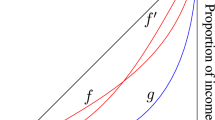Abstract
The similarities and dissimilarities among incomes of two or more groups are studied using several different measures. Two of such measures, one overlap-based and one distance-based are studied here. Weitzman (1970) introduced coefficient of community to study income distributions of different social groups in the United States. However, this study involved no distributional assumption about the incomes of families in different groups. Because, the classical Pareto law has proven to be a convenient model to describe income distributions, a continuous counterpart of coefficient of community and a variation of Hellinger’s distance are developed to study income equalities under the assumption of Pareto model. The estimators of both the measures are found to be biased, and hence the expressions are derived for evaluating the amount of bias in estimates. The mean squared errors and bias of estimates are studied using Monte Carlo technique for different sample sizes.
Similar content being viewed by others
References
Arnold, B.C., Laguna, L., 1977. On generalized Pareto distributions with applications to income data. Tech. Rep., Dept. of Economics, Iowa State Univ., Ames, IA.
Berger, J.M., Mandelbrot, B., 1963. A new model for error clustering in telephone circuits. IBM Journal, 224–236.
Brazauskas, V., Jones, B.L., Zitikis, R., 2009. Robust fitting of claim severity distributions and the method of trimmed moments. J. Stat. Planning and Inference, 139, 2028–2043.
Dagum, C., 1985. Analysis of income distribution and inequality by education and sex in Canada. Advances in Econometrics, 4, 167–227.
Good, I.J., Smith, E.P., 1985. The variance and covariance of a generalized index of similarity especially for a generalization of an index of Hellinger and Bhattacharyya. Communications in Statistics — Theory and Methods, 14, 3053–3061.
Grimshaw, S.D., 1993. Computing maximum likelihood estimates for the generalized Pareto distribution. Technometrics, 35, 85–191.
Inman, H.F., Bradley, E.L., 1984. The overlapping coefficient as a measure of association in 2 × K contingency tables. Presented at Winter meeting of Alabama Chapter of American Statistical Association Meeting, Birmingham, AL.
Inman, H.F., Bradley, E.L., 1991. Approximations to the mean and variance of the index of dissimilarity in 2 × C tables under a random allocation model. Sociological Methods and Research, 20, 242–255.
Johnson, N.L., Kotz, S., Balakrishanan, N., 1994. Continuous Univariate distributions–I, 2nd edition, John Wiley and Sons, New York, NY.
Littlewood, B., 1981. Stochastic reliability-growth: a model for fault-removal in computer-programs and hardware-designs. IEEE Transactions on Reliability, 30, 313–320.
Matusita, K, 1955. Decision rules based on the distance for problems of fit, two samples and estimation. Annals of Mathematical Statistics, 26, 631–640.
Mimoto, N., Zitikis, R., 2009. Czekanowski’s index of overlap, its Lp-type extension, and bias reduction. American Journal of Mathematical & Management Sciences, 29, 229–261.
Mulekar, M.S., Gonzales, S., Aryal, S., 2008. Bias and variance estimates for the overlap of two exponential populations. American Journal of Mathematical & Management Sciences, 28, 61–79.
Mulekar, M.S., Mishra, S.N., 1994. Overlap coefficients of two normal densities: Equal means case. Journal of Japan Statistical Society, 2(24), 169–180.
Mulekar, M.S., Mishra, S.N., 1997. Inference on measures of niche overlap for heteroscedastic normal populations. American Journal of Mathematical & Management Sciences, 17, 163–185.
Mulekar, M.S., Mishra, S.N., 2000. Confidence interval estimation of overlap: equal means case. Computational Statistics & Data Analysis, 34, 121–137.
Pareto, V., 1897. Cours d’Economie Politique. Rouge and Cie, Lausanne and Paris.
Quandt, R.E., 1966. Old and new methods of estimation and Pareto distribution. Metrika, 10, 55–82.
Ricklefs, R.E., Lau, M., 1980. Biasand Dispersion of overlap indices: results of some Monte Carlo simulations. Ecology, 6, 1019–1024.
Sen, A., 1973. On Economic Inequality. Oxford University Press, Oxford.
Shorrocks, A.F., 1982. On the distance between income distributions. Econometrika, 50, 1337–1339.
Weitzman, M.S., 1970. Measures of overlap of income distributions of white and negro families in the United States. Technical Paper 22, US Department of Commerce, Bureau of the Census, Washington.
Yitzhaki, S., 1994. Economic distance and overlapping of distributions. J. Econometrics, 61, 147–159.
Yitzhaki, S., Lerman, R., 1991. Income stratification and income inequality. Review of Income and Wealth, 37, 313–329.
Author information
Authors and Affiliations
Corresponding author
Rights and permissions
About this article
Cite this article
Mulekar, M.S., Fukasawa, T. Estimation of Statistical Measures of Income Similarity. J Stat Theory Pract 4, 743–755 (2010). https://doi.org/10.1080/15598608.2010.10412016
Received:
Revised:
Published:
Issue Date:
DOI: https://doi.org/10.1080/15598608.2010.10412016




